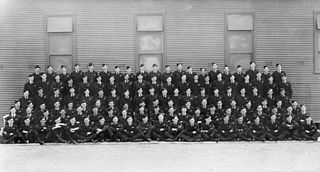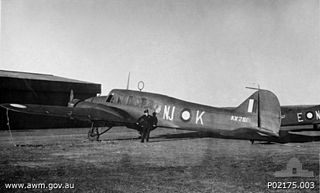
No. 1 Operational Training Unit (No. 1 OTU) was an operational conversion unit of the Royal Australian Air Force (RAAF) during World War II. Formed in December 1941 at Nhill, Victoria, it relocated to Bairnsdale in mid-1942, and then to East Sale the following year. No. 1 OTU's primary role was to train aircrew for multi-engined aircraft operations. At its peak of activity in August 1944, it was operating over 130 aircraft, the most numerous being Bristol Beauforts. Its aircraft and personnel also conducted transport missions in New Guinea and maritime patrols in southern Australian waters. Following the end of hostilities, the unit was disbanded in December 1945.

No. 16 Air Observation Post Flight was a Royal Australian Air Force (RAAF) unit that saw action in World War II supporting Australian Army operations. It was formed in October 1944 and disbanded in June 1947. The flight was reestablished in September 1958, and was disbanded again in December 1960, when its responsibilities were transferred to a joint Army-RAAF unit.

No. 13 Squadron is a Royal Australian Air Force (RAAF) squadron. The squadron saw combat during World War II as a bomber and maritime patrol squadron and is currently active as a mixed regular and reserve RAAF unit located in Darwin, fulfilling both operational support and training duties.

No. 14 Squadron was a Royal Australian Air Force maritime patrol squadron of World War II. It was formed in 1939 and was based in Western Australia throughout the war. While it conducted many patrols over the waters off Western Australia, it did not see combat. The squadron was disbanded in December 1945.

No. 12 Squadron was a Royal Australian Air Force (RAAF) general purpose, bomber and transport squadron. The squadron was formed in 1939 and saw combat in the South West Pacific theatre of World War II. From 1941 to 1943, it mainly conducted maritime patrols off northern Australia. The squadron was based at Merauke in western New Guinea from November 1943 to July 1944, when it was withdrawn from operations. After being re-equipped, it operated as a heavy bomber unit from February 1945 until the end of the war. The squadron continued in this role until it was redesignated No. 1 Squadron RAAF in February 1948. The squadron was reformed in 1973 to operate transport helicopters but was again disbanded in 1989.

No. 66 Squadron was a Royal Australian Air Force (RAAF) maritime patrol squadron of World War II. It was formed in May 1943 as an emergency measure and disbanded in January 1944.

No. 67 Squadron was a Royal Australian Air Force (RAAF) maritime patrol squadron of World War II. It was formed in January 1943, conducted patrols off the southern Australian coastline until the end of the war, and was disbanded in November 1945.
No. 92 Squadron was a Royal Australian Air Force (RAAF) ground attack squadron of World War II. It was raised in May 1945 to operate Bristol Beaufighter aircraft, but had not completed its training by the end of the war in August and was disbanded the following month.

No. 102 Squadron was a Royal Australian Air Force (RAAF) heavy bomber squadron of World War II. The squadron was only active for less than nine months before being disbanded. No. 102 Squadron was formed at Cecil Plains, Queensland on 31 May 1945. The Squadron's B-24 Liberator bombers arrived in July. While the Squadron began training on these aircraft, the war ended before it reached operational status. Following the end of the war the squadron operated in the transport role until December 1945. No. 102 Squadron was disbanded on 19 March 1946.

No. 15 Squadron was a Royal Australian Air Force (RAAF) light bomber and maritime patrol squadron of World War II. The squadron was formed in January 1944 and initially flew anti-submarine patrols off the east coast of Australia. From September that year elements of the squadron took part in the New Guinea Campaign, and the main body of the squadron moved to New Guinea in March 1945. Its duties in New Guinea included anti-submarine and anti-barge patrols as well as attacking Japanese positions. No. 15 Squadron was demobilised after the end of the war, and was formally disbanded in March 1946.

No. 84 Wing is a Royal Australian Air Force (RAAF) transport wing. Coming under the control of Air Mobility Group (AMG), it is headquartered at RAAF Base Richmond, New South Wales. The wing comprises No. 35 Squadron, operating Aliena C-27J Spartan transport Aircraft; No. 37 Squadron, operating Lockheed Martin C-130J Super Hercules medium transports; and a technical training unit, No. 285 Squadron.

No. 71 Squadron was a Royal Australian Air Force (RAAF) maritime patrol squadron of World War II. It was formed in January 1943 and conducted patrols off the east coast of Australia until it was disbanded in August 1944.

No. 73 Squadron was a Royal Australian Air Force (RAAF) maritime patrol squadron of World War II. It was formed in July 1942 and conducted patrols off the east coast of Australia until July 1944. The squadron was disbanded in September 1944.

The Governor-General's Flight was a Royal Australian Air Force transport unit. The Governor-General's Flight was formed at RAAF Station Canberra on 4 April 1945. The unit was equipped with an Avro York named 'Endeavour', an Avro Anson and a Percival Proctor. Although the Flight initially only provided transport for the Governor-General of Australia its role was later expanded to include carrying the Prime Minister and other dignitaries. The Governor-General's Flight was disbanded on 10 July 1947 and No. 1 Communication Unit assumed responsibility for VIP transport. The Flight was re-raised on 1 July 1948 equipped with a B-24 Liberator and a Dakota. The Flight was disbanded for a second and final time on 1 October 1950 with the VIP transport role being transferred to No. 36 Squadron.

No. 17 Air Observation Post Flight was a Royal Australian Air Force artillery-spotting and liaison unit which saw action as part of the Bougainville campaign and New Britain campaign in World War II. The flight was established in October 1944 and disbanded in December the next year.

No. 8 Squadron was an Australian flying training squadron of World War I and medium bomber squadron of World War II. The squadron was formed in England in October 1917 as part of the Australian Flying Corps, and disbanded in April 1919. It was re-formed by the Royal Australian Air Force in September 1939. After seeing action during the Pacific War flying Lockheed Hudson and, later, DAF Beaufort bombers, the squadron was disbanded a second time in January 1946.

No. 2 Air Ambulance Unit RAAF was a Royal Australian Air Force air ambulance unit of World War II. The Unit was formed on 1 March 1942 at RAAF Base Fairbairn and flew its first operational sortie on 7 March. No. 2 Air Ambulance Unit operated throughout Australia during 1942 and began flights to New Guinea in 1943.

John Raeburn Balmer, was a senior officer and bomber pilot in the Royal Australian Air Force (RAAF). Born in Bendigo, Victoria, he studied law before joining the RAAF as an air cadet in 1932. An instructor at Point Cook from 1935 to 1937, he achieved renown in Air Force circles when he reportedly parachuted from a training aircraft to motivate his pupil to land single-handedly. He also became known to the general public as a cross-country motorist, setting records for trans-Australia and round-Australia trips prior to World War II.

No. 8 Service Flying Training School was a flying training school of the Royal Australian Air Force (RAAF) that operated during World War II. It was formed in December 1941, and graduated its first course in March 1942. Responsible for intermediate and advanced instruction of pilots under the Empire Air Training Scheme (EATS), the school was based at RAAF Station Bundaberg, Queensland, and operated Avro Anson aircraft. It spawned two maritime patrol squadrons in early 1943, raised in response to increased Japanese submarine activity off Australia's east coast. Some of the school's aircraft were also attached to the Australian Army in 1944–45. No. 8 SFTS completed its final training course in December 1944, and was disbanded in July 1945.

Western Area Command was one of several geographically based commands raised by the Royal Australian Air Force (RAAF) during World War II. It was formed in January 1941, and controlled RAAF units located in Western Australia. Headquartered in Perth, Western Area Command was responsible for air defence, aerial reconnaissance and protection of the sea lanes within its boundaries. Its aircraft conducted anti-submarine operations throughout the war, and attacked targets in the Dutch East Indies during the Borneo campaign in 1945.
George James Odgers (1916–2008) was an Australian soldier, journalist and military historian. Odgers served in the Australian Army as a private soldier and non-commissioned officer; and later in the Royal Australian Air Force becoming a group captain. He was one of the authors of the official history of Australia in World War II, Australia in the War of 1939–1945.

The Australian War Memorial is Australia's national memorial to the members of its armed forces and supporting organisations who have died or participated in wars involving the Commonwealth of Australia, and some conflicts involving personnel from the Australian colonies prior to Federation. The memorial includes an extensive national military museum. The Australian War Memorial was opened in 1941, and is widely regarded as one of the most significant memorials of its type in the world.

OCLC Online Computer Library Center, Incorporated d/b/a OCLC is an American nonprofit cooperative organization "dedicated to the public purposes of furthering access to the world's information and reducing information costs". It was founded in 1967 as the Ohio College Library Center. OCLC and its member libraries cooperatively produce and maintain WorldCat, the largest online public access catalog (OPAC) in the world. OCLC is funded mainly by the fees that libraries have to pay for its services. OCLC also maintains the Dewey Decimal Classification system.
























